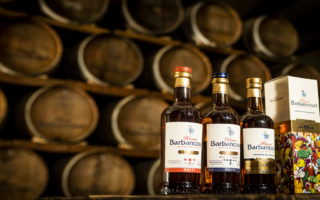French Flavours: Salt
At the Cours Saleya market in Nice, wicker baskets overflow with salt in every shade of the rainbow. You can buy it flavoured with sun-dried tomato or saffron, seaweed or wasabi…
For me, though, there is nothing more beautiful than the plain, rough-textured grey sea salt harvested from just off the Atlantic coast. Handfuls of this natural, mineral-rich salt go into my pasta water and generous pinches bring depth to slow-cooked onions for pissaladi�re, gently bubbling lentils with sausages or my almost daily pots of pur�ed vegetable soup.
Although I gave up iodized salt decades ago because I found its flavour too harsh, I really came to appreciate sel gris when I spent time on the �le de R�. The nearby Gu�rande peninsula produces more salt, but the islands of R� and Noirmoutier are both known to the kind of connoisseur who can detect the aroma of violet in fresh fleur de sel, the pure salt that is harvested from the surface of the water. Curious to find out why �le de R�’s salt is said to be among the best in the world, I spent an afternoon visiting the salt marshes with a knowledgeable guide whose name, Christelle, seemed fitting.
At first there didn’t appear to be much to see, just stretches of orderly square puddles bordered by paths. But the process of harvesting salt turned out to be fascinating. The ingenious technique dates from the 12th and 13th centuries, and nobody has found a reason to change it since. Salt producers, called paludiers north of the Loire river and sauniers (after the medieval word for salt) in the south, have used the same tools for hundreds of years, although some of the hoes and rakes are now made of fibreglass rather than wood.
Because the salt marshes are below sea level, the seawater comes through a dyke into a large pool. From there, the sauniers (the �le de R� is south of the Loire) control its flow through a system of canals and dams using simple slats of wood. The water moves through the flats like a maze, with each series of square basins lower and shallower than the last. Harvesting can only take place in the summer, when the sun and wind evaporate the water over a period of ten days to two weeks. By the time the salt is ready to harvest, there is very little water left, and the sauniers use rakes and hoes on long poles to scrape it into piles and pick it up. In the winter, their job is to keep the natural clay basins clean so that the unrefined salt will be free from impurities.
The saunier’s wife is traditionally in charge of gently raking off the fleur de sel, which is prized for its light crunch and delicate taste. With smaller crystals than sel gris, this pricier salt is perfect for sprinkling on to just about any food at the last moment (which allows you to use less salt during the cooking). A match of unexpected brilliance is fleur de sel with chocolate, as you’ll see in the recipe on this page. I had often wondered why the Atlantic fleur de sel tastes better than fleur de sel de Camargue from near Marseille and Christelle finally cleared up the mystery. She told me that the hot, dry climate of the Mediterranean causes the water to evaporate faster, resulting in a bitter-tasting salt that needs to be refined before it can be eaten. The Atlantic coast, it seems, has the right combination of sun, wind and rain. Tempting as the display looks at the market, supermarkets stock plain sea salt at much better prices. At around €2 a kilo, I don’t have to worry about throwing a handful of grey salt into my pasta water or baking a whole sea bass or bream in a salt crust.
Fine grey sea salt goes into my breads and cakes – it’s amazing how a little salt lifts the taste of anything sweet – and serves as a seasoning for meat, fish and salad dressings. I can’t imagine cooking without natural sea salt, and for this I’m grateful to the sauniers and their long-handled rakes. Chocolate mousse with fleur de sel Serves 4-6
I first discovered the remarkable way that salt highlights the flavour of chocolate when I tasted Paris p�tissier Pierre Herm�’s salted chocolate sabl�s. This chocolate mousse contains a generous pinch of fleur de sel, and you can sprinkle a little more salt on top when you serve it.
• 5 extra-fresh eggs • 200g high-quality chocolate, around 65 per cent cocoa solids (7�oz) • 50g butter (2oz) • Fleur de sel • A pinch of fine sea salt • 50g white sugar (2oz)
1. Chop the chocolate with a large knife and melt it with the butter in a bowl over simmering water. Set aside to cool to lukewarm. 2. Meanwhile, separate the eggs. Whisk the yolks one by one into the chocolate-butter mixture, followed by a generous pinch of fleur de sel. In a mixer, beat the egg whites with a pinch of fine salt until fairly stiff, adding the sugar towards the end. 3. Whisk �/3 of the egg whites into the chocolate mixture to lighten it, then fold in the remaining egg whites. Transfer to a large bowl or several small serving dishes. Chill for at least 2 hours (preferably longer) before serving.
Share to: Facebook Twitter LinkedIn Email


